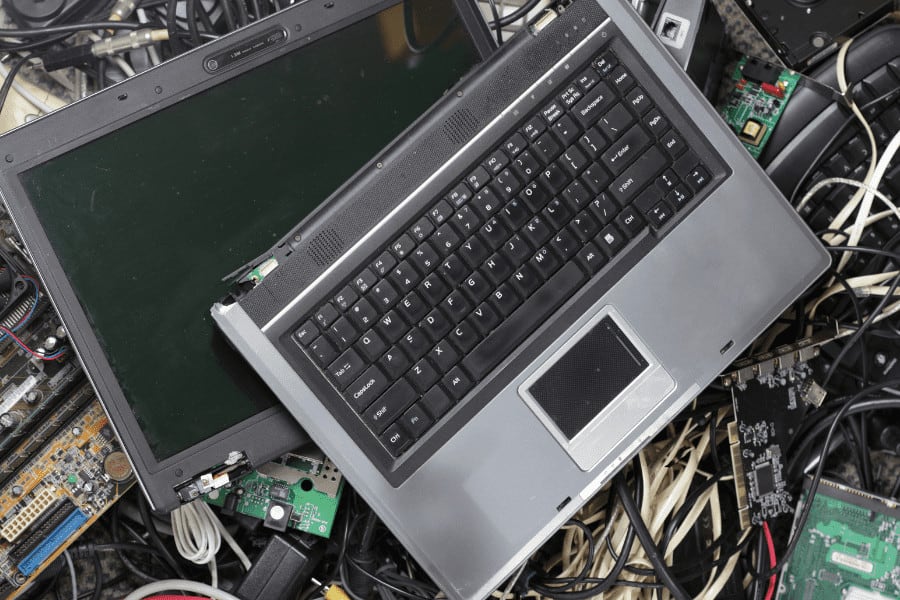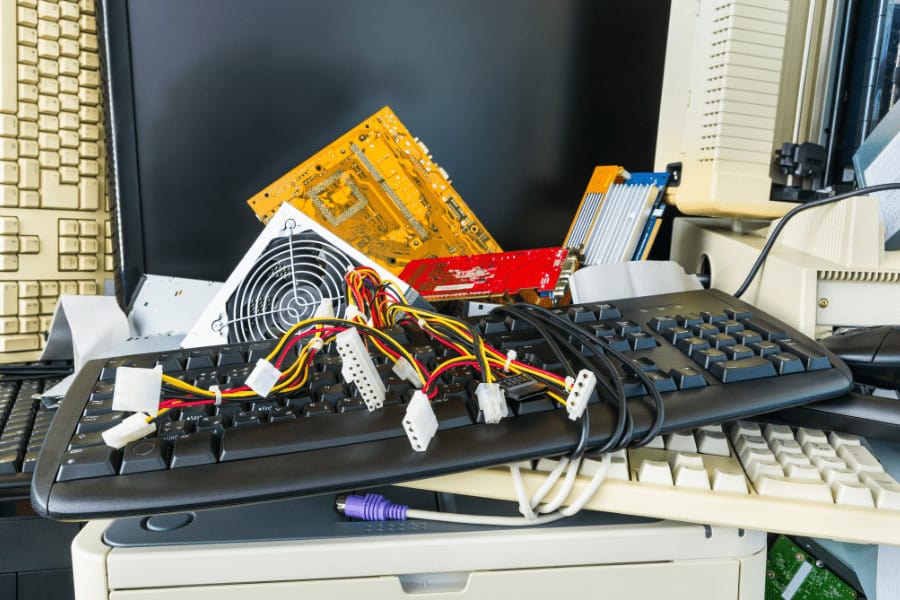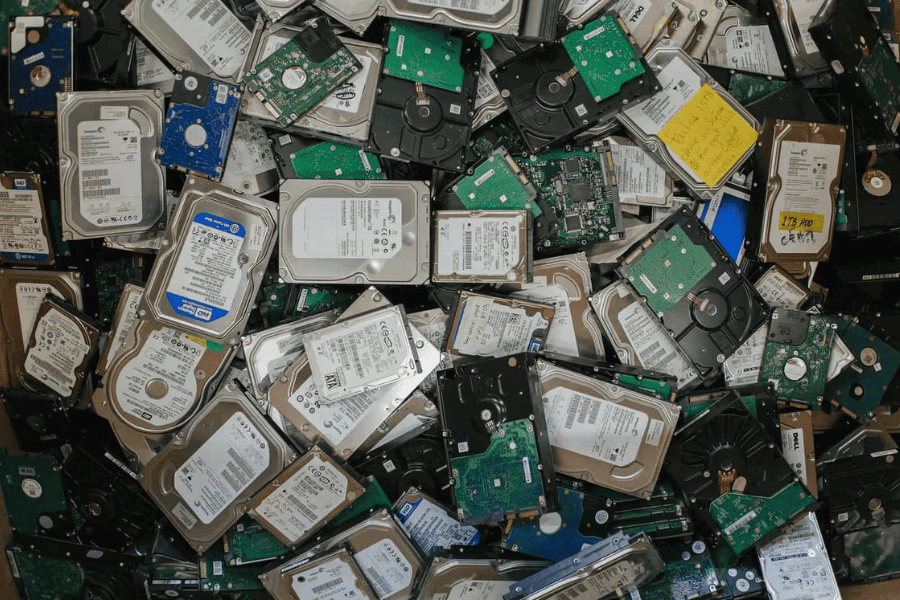
According to the UN’s Global E-waste Monitor 2020, 53.6 million metric tons of e-waste were generated worldwide in 2019, up 21 percent over the previous five years. And this number is expected to grow to 74.7 million metric tons by 2030.
At this rate, e-waste is currently the world’s fastest-growing waste stream. And if left unchanged, it could have devastating effects on our environment.
So what can be done about the growing challenge of e-waste? It turns out, a lot.
What Is E-Waste?
 E-waste — or electronic waste — is the term used for discarded electronic devices, including computers, cell phones, TVs, speakers, video gaming systems, and more.
E-waste — or electronic waste — is the term used for discarded electronic devices, including computers, cell phones, TVs, speakers, video gaming systems, and more.
Electronics contain toxic materials, including heavy metals like lead, mercury, and cadmium as well as PVC plastic and hazardous chemicals. When e-waste ends up in a landfill, these toxic substances can contaminate habitats and leach into groundwater, affecting people, animals, and plant life.
What’s more, e-waste in landfills isn’t just bad for the environment — it’s a waste of valuable resources. Electronic devices are made up of a mix of high-value elements such as gold, silver, copper, platinum, lithium, and cobalt…all of which can be reclaimed and reused through recycling.
What’s Contributing to the Growth of E-Waste?
There are a number of reasons for the rapid growth of e-waste, including increased demand, decreasing device lifespan, the complexity of the recycling process, and lack of legislation surrounding electronics recycling.
Increasing Demand for Electronics
 One of the biggest reasons for the increase in e-waste is that technology is becoming a bigger part of our lives. Smart watches, smart TVs, smart homes, remote work and learning…as every part of our lives goes digital, the demand for electronics increases.
One of the biggest reasons for the increase in e-waste is that technology is becoming a bigger part of our lives. Smart watches, smart TVs, smart homes, remote work and learning…as every part of our lives goes digital, the demand for electronics increases.
At this point, it’s difficult to take part in day-to-day life without a smartphone or internet access. In many ways, technology is no longer a luxury — it’s a necessity. And that isn’t necessarily a bad thing: technology improves our lives in many ways, such as providing wider access to information, communication, and educational opportunities.
Decreasing Device Lifespan
At the same time that demand for electronics is increasing, device life span is decreasing. With frequent updates, cell phones and other devices are often obsolete after only a few years. When you add to that the lack of manufacturer support for old devices and issues with right to repair, it is often cheaper and easier to buy new electronics than to repair old ones.
Complex Process
Even when it is recycled, e-waste is difficult to process, due to the complex makeup of devices. With multiple materials that need to be sorted and recycled separately, it can be an extremely inefficient (and therefore expensive) process.
Lack of Legislation
There are currently no federal U.S. laws mandating electronics recycling. Many states have their own e-waste recycling laws, but they vary widely (here’s an overview of Minnesota’s electronic waste recycling rules).
Want to help tackle the growing e-waste problem by developing an effective, secure and profitable IT asset disposition (ITAD) program for your business? Download our free guide here!
Solutions to the Challenge of E-Waste
 The challenge that e-waste presents is a significant one. But there are solutions to this problem — and where there are solutions, there is hope. A few of the things that would significantly reduce e-waste are:
The challenge that e-waste presents is a significant one. But there are solutions to this problem — and where there are solutions, there is hope. A few of the things that would significantly reduce e-waste are:
- Improved design. Designing electronic goods that are safer (using fewer toxic materials), more durable, repairable, and recyclable is key. Unfortunately most manufacturers don’t prioritize producing goods that can be reused or refurbished. But consumer demand for such products could change that.
- Extended Producer Responsibility legislation. This legislation would require manufacturers to take responsibility for the management and disposal of the products they make. The goal of this strategy is to encourage manufacturers to reuse waste materials in the manufacturing of new products, as well as to increase the rate of recycling through manufacturer funding.
- More options for recycling and refurbishing. While the electronics recycling industry is growing, less than 20 percent of the world’s e-waste is being recycled (as of 2019). Making electronics recycling more accessible and refurbished devices more widely available would help increase that rate. The easier (and cheaper) it is for consumers to recycle, the more likely they will be to do so. Did you know? Our retail division helps minimize environmental impact by promoting reuse before recycling. They offer high quality refurbished and vintage electronics along with new.
- Right to Repair legislation. Copyright laws, EULAs, and other rules often keep consumers from repairing their own electronic devices. If adopted, Right to Repair legislation would require manufacturers to make parts, tools, and information available to both consumers and repair shops so that devices can be more easily repaired.
- Circular economy. A circular economy is one that seeks to reduce material use, redesign materials to use fewer resources, and reclaim waste as a resource to manufacture new materials and products. The goal of a circular economy is to keep products and their components in circulation (ideally as the original product, or remade into new products), rather than tossing them in a landfill. In addition to keeping electronics out of landfills, a more circular process could save billions of dollars a year through reusing valuable materials that would otherwise go to waste.
How You Can Help Reduce E-Waste…One Device at a Time
 While many of these solutions rely on passing legislation and changing the way products are manufactured, there are ways you can help reduce e-waste at home.
While many of these solutions rely on passing legislation and changing the way products are manufactured, there are ways you can help reduce e-waste at home.
- Hold off on buying new electronics until you really need them.
- When you do buy, buy refurbished. (Repowered makes shopping refurbished easy!)
- Repair old electronics when possible.
- Recycle with a certified responsible e-waste recycler like Repowered.
Have electronics that need recycling? Learn more about recycling with Repowered here, then load up your car and come see us at one of our drop-off locations!
Recent News & Articles

Celebrating Juneteenth

Harnessing the Economic Potential of E-Waste Recycling: A New MN Study


